Improving the Nutrient Management of an Apple Orchard by Using Organic-Based Composites Derived from Agricultural Waste
Abstract
1. Introduction
2. Materials and Methods
2.1. Study Site
2.2. Climatic Conditions
2.3. Applied Composites and Doses
2.4. Soil Characteristics
2.5. Characterization of Leaves and Fruits
2.6. Statistical Analysis
3. Results and Discussion
3.1. Soil Analysis
3.2. Leaf Analysis
3.3. Fruit Analysis
4. Conclusions
Author Contributions
Funding
Data Availability Statement
Acknowledgments
Conflicts of Interest
References
- USDA—U.S. Department of Agriculture. 2023. Available online: https://www.usda.gov/ (accessed on 23 September 2023).
- Fruitveb Hungarian Vegetable and Fruit Trade Organization and Product Council. 2023. Available online: https://fruitveb.hu/tag/alma/ (accessed on 5 October 2023).
- Nagy, P.T. Plant nutritional and environmental aspects of organic apple production in East Hungary. Ecocycles 2017, 3, 17–21. [Google Scholar] [CrossRef][Green Version]
- Fageria, N.K. Role of Soil Organic Matter in Maintaining Sustainability of Cropping Systems. Commun. Soil Sci. Plant Anal. 2012, 43, 2063–2113. [Google Scholar] [CrossRef]
- Panagos, P.; Hiederer, R.; Van Liedekerke, M.; Bampa, F. Estimating soil organic carbon in Europe based on data collected through an European network. Ecol. Indic. 2013, 24, 439–450. [Google Scholar] [CrossRef]
- Yigini, Y.; Panagos, P. Assessment of soil organic carbon stocks under future climate and land cover changes in Europe. Sci. Total Environ. 2016, 557-558, 838–850. [Google Scholar] [CrossRef] [PubMed]
- Manogaran, D.M.; Shamsuddin, R.; Yusoff, M.H.M.; Lay, M.; Siyal, A.A. A review on treatment processes of chicken manure. Clean. Circ. Bioecon. 2022, 2, 100013. [Google Scholar] [CrossRef]
- Hanč, A.; Tlustoš, P.; Száková, J.; Balík, J. The influence of organic fertilizers application on phosphorus and potassium bioavailability. Plant Soil Environ. 2008, 54, 247–254. [Google Scholar] [CrossRef]
- Ravindran, B.; Mupambwa, H.A.; Silwana, S.; Mnkeni, P.N.S. Assessment of nutrient quality, heavy metals and phytotoxic properties of chicken manure on selected commercial vegetable crops. Heliyon 2017, 3, E00493. [Google Scholar] [CrossRef] [PubMed]
- Amanullah, M.M.; Muthukrishnan, P.; Sekar, S. Prospects and potential of poultry manure. Asian J. Plant Sci. 2010, 9, 172–182. [Google Scholar] [CrossRef]
- Abobatta, W. Impact of hydrogel polymer in agricultural sector. Adv. Agric. Environ. Sci. 2018, 1, 59–64. [Google Scholar] [CrossRef]
- Fernández, P.L.; Behrends Kraemer, F.; Sabatté, L.; Guiroy, J.; Gutierrez Boem, F. Superabsorbent Polyacrylamide Effects on Hydrophysical Soil Properties and Plant Biomass in a Sandy Loam soil. Commun. Soil Sci. Plant Anal. 2022, 53, 2892–2906. [Google Scholar] [CrossRef]
- Patra, S.K.; Poddar, R.; Brestic, M.; Acharjee, P.U.; Bhattacharya, P.; Sengupta, S.; Pal, P.; Bam, N.; Biswas, B.; Barek, W.; et al. Prospects of Hydrogels in Agriculture for Enhancing Crop and Water Productivity under Water Deficit Condition. Int. J. Polym. Sci. 2022, 3, E00493. [Google Scholar] [CrossRef]
- Malik, S.; Chaudhary, K.; Malik, A.; Punia, H.; Sewhag, M.; Berkesia, N.; Nagora, M.; Kalia, S.; Malik, K.; Kumar, D.; et al. Superabsorbent Polymers as a Soil Amendment for Increasing Agriculture Production with Reducing Water Losses under Water Stress Condition. Polymers 2023, 15, 161. [Google Scholar] [CrossRef] [PubMed]
- Gaikwad, G.S.; Vilhekar, S.C.; Mane, P.N.; Vaidya, E.R. Impact of organic manures and hydrophilic polymer hydrogel on conservation of moisture and sunflower production under rainfed condition. Adv. Res. J. Crop Improv. 2017, 8, 31–35. [Google Scholar] [CrossRef]
- Liu, X.; Chan, Z.L. Application of potassium polyacrylate increases soil water status and improves growth of bermudagrass (Cynodon dactylon) under drought stress condition. Sci. Hortic. 2015, 197, 705–711. [Google Scholar] [CrossRef]
- Seybold, C.A. Polyacrylamide review: Soil conditioning and environmental fate. Commun. Soil Sci. Plant Anal. 1994, 25, 2171–2185. [Google Scholar] [CrossRef]
- Behera, S.; Mahanwar, P.A. Superabsorbent polymers in agriculture and other applications: A review. Polym.—Plast. Technol. Mater. 2019, 59, 341–356. [Google Scholar] [CrossRef]
- Grabowska-Polanowska, B.; Garbowski, T.; Bar-Michalczyk, D.; Kowalczyk, A. The benefits of synthetic or natural hydrogels application in agriculture: An overview article. J. Water Land Dev. 2021, 51, 208–224. [Google Scholar] [CrossRef]
- Mi, J.; Gregorich, E.G.; Xu, S.; McLaughlin, N.B.; Liu, J. Effect of bentonite as a soil amendment on field water-holding capacity, and millet photosynthesis and grain quality. Sci. Rep. 2020, 10, 18282. [Google Scholar] [CrossRef]
- Fayek, M.A.; Abdel-Mohsen, M.A.; Sanaa, I.L.; El-Sayed, S.M. Impact of Super Absorbent Polymer and bentonite as soil amendments under irrigation regimes in olive orchard. Plant Arch. 2020, 20, 723–730. [Google Scholar]
- Czaban, J.; Siebielec, G.; Niedźwiecki, J. Effects of bentonite addition on sandy soil chemistry in a long-term experiment (I); Effect on organic carbon and total nitrogen. Pol. J. Environ. Stud. 2013, 22, 1661–1667. [Google Scholar]
- Czaban, J.; Siebielec, G. Effects of Bentonite on Sandy Soil Chemistry in a Long-Term Plot Experiment (II); Effect on pH, CEC, and Macro- and Micronutrients. Pol. J. Environ. Stud. 2013, 22, 1669–1676. [Google Scholar]
- Bio-Fer Natur Extra Product. 2023. Available online: https://bio-fer.hu/bio-fer-natur-extra/ (accessed on 9 October 2023).
- Kátai, J.; Tállai, M.; Sándor, Z.; Zsuposné, O.Á. Effect of Bentonite and Zeolite on some characteristics of acidic sandy soil and on the biomass of a test plant. Agrokémia Talajt. 2010, 1, 165–174. [Google Scholar] [CrossRef][Green Version]
- Madramootoo, C.A.; Jain, A.; Oliva, C.; Wang, Y.; Abbasi, N.A. Growth and yield of tomato on soil amended with waste paper based hydrogels. Sci. Hortic. 2023, 310, 111752. [Google Scholar] [CrossRef]
- MSZ 20135:1999; Determination of the Soluble Nutrient Element Content of the Soil. Hungarian Standards Institution: Budapest, Hungary, 1999. (In Hungarian)
- Mendiburu, F. Agricolae: Statistical Procedures for Agricultural Research. R Package Version 4.1.3-0. 2019. Available online: https://cran.r-project.org/package=agricolae (accessed on 26 August 2023).
- Kobierski, M.; Bartkowiak, A.; Lemanowicz, J.; Piekarczyk, M. Impact of poultry manure fertilization on chemical and biochemical properties of soils. Plant Soil Environ. 2017, 63, 558–563. [Google Scholar] [CrossRef]
- Zhang, C.; Zhao, Z.; Li, F.; Zhang, J. Effects of Organic and Inorganic Fertilization on Soil Organic Carbon and Enzymatic Activities. Agronomy 2022, 12, 3125. [Google Scholar] [CrossRef]
- Ren, F.; Zhang, R.; Sun, N.; Li, Y.; Xu, M.; Zhang, F.; Xu, W. Patterns and driving factors of soil organic carbon sequestration efficiency under various manure regimes across Chinese croplands. Agric. Ecosyst. Environ. 2024, 359, 108723. [Google Scholar] [CrossRef]
- Yang, Y.; Wu, J.; Zhao, S.; Gao, C.; Pan, X.; Tang, D.W.S.; van der Ploeg, M. Effects of long-term super absorbent polymer and organic manure on soil structure and organic carbon distribution in different soil layers. Soil Tillage Res. 2021, 206, 104781. [Google Scholar] [CrossRef]
- Wang, X.L.; Ye, J.; Perez, P.G.; Tang, D.M.; Huang, D.F. The impact of organic farming on the soluble organic nitrogen pool in horticultural soil under open field and greenhouse conditions: A case study. Soil Sci. Plant Nutr. 2013, 59, 237–248. [Google Scholar] [CrossRef]
- Canali, S.; Trinchera, A.; Intrigliolo, F.; Pompili, L.; Nisini, L.; Mocali, S.; Torrisi, B. Effect of long term addition of composts and poultry manure on soil quality of citrus orchards in Southern Italy. Biol. Fertil. Soils 2004, 40, 206–210. [Google Scholar] [CrossRef]
- Yagüe, M.R.; Lobo, M.C.; García, P. Organic fertilisation induces changes in soil nitrogen mineralisation and enzyme activities. Plant Soil Environ. 2023, 69, 38–43. [Google Scholar] [CrossRef]
- Ali, M.A.; Farag, S.G.; Sillanpää, M.; Al-Farraj, S.; El-Sayed, M.E.A. Efficiency of Using Superabsorbent Polymers in Reducing Mineral Fertilizer Rates Applied in Autumn Royal Vineyards. Horticulturae 2023, 9, 451. [Google Scholar] [CrossRef]
- Qiao, D.; Liu, H.; Yu, L.; Bao, X.; Simon, G.P.; Petinakis, E.; Chen, L. Preparation and characterization of slow-release fertilizer encapsulated by starch-based superabsorbent polymer. Carbohydr. Polym. 2013, 147, 146–154. [Google Scholar] [CrossRef] [PubMed]
- Keivanfar, S.; Ghazvini, R.F.; Ghasemnezhad, M.; Mousavi, A.; Khaledian, M.R. Effects of regulated deficit irrigation and superabsorbent polymer on fruit yield and quality of ‘Granny Smith’ apple. Agric. Sci. 2019, 84, 383–389. Available online: https://hrcak.srce.hr/228927 (accessed on 10 January 2024).
- Cen, Y.; Li, L.; Guo, L.; Li, C.; Jiang, G. Organic management enhances both ecological and economic profitability of apple orchard: A case study in Shandong Peninsula. Sci. Hortic. 2020, 265, 109201. [Google Scholar] [CrossRef]
- Serpen, J.Y. Comparison of Sugar Content in Bottled 100% Fruit Juice versus Extracted Juice of Fresh Fruit. Food Nutr. Sci. 2012, 3, 1509–1513. [Google Scholar] [CrossRef]
- Zoghdan, M.G.; Abo El-Enien, M.M.S. Irrigation regime and soil conditioners impact on characteristics of sandy soil and Washington navel orange trees. J. Soil Sci. Agric. Eng. 2019, 10, 233–243. [Google Scholar] [CrossRef]
- Solanki, R.; Bisen, B.P.; Pandey, S.K. Efficacy of super absorbent polymer and irrigation scheduling on quality attributes in acid lime. Pharma Innov. 2021, 10, 12–15. [Google Scholar] [CrossRef]
- Kai, T.; Adhikari, D. Effect of Organic and Chemical Fertilizer Application on Apple Nutrient Content and Orchard Soil Condition. Agriculture 2021, 11, 340. [Google Scholar] [CrossRef]

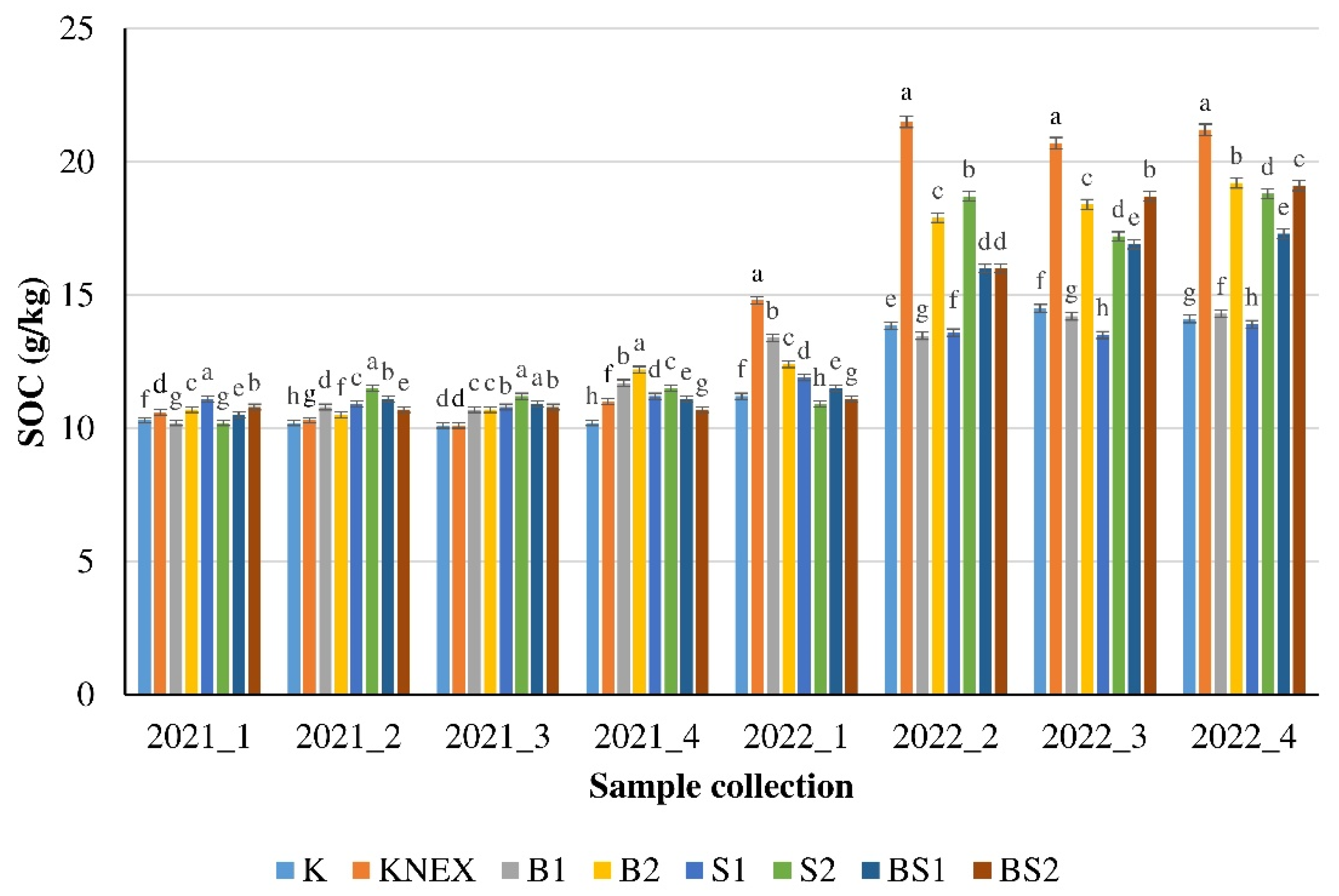
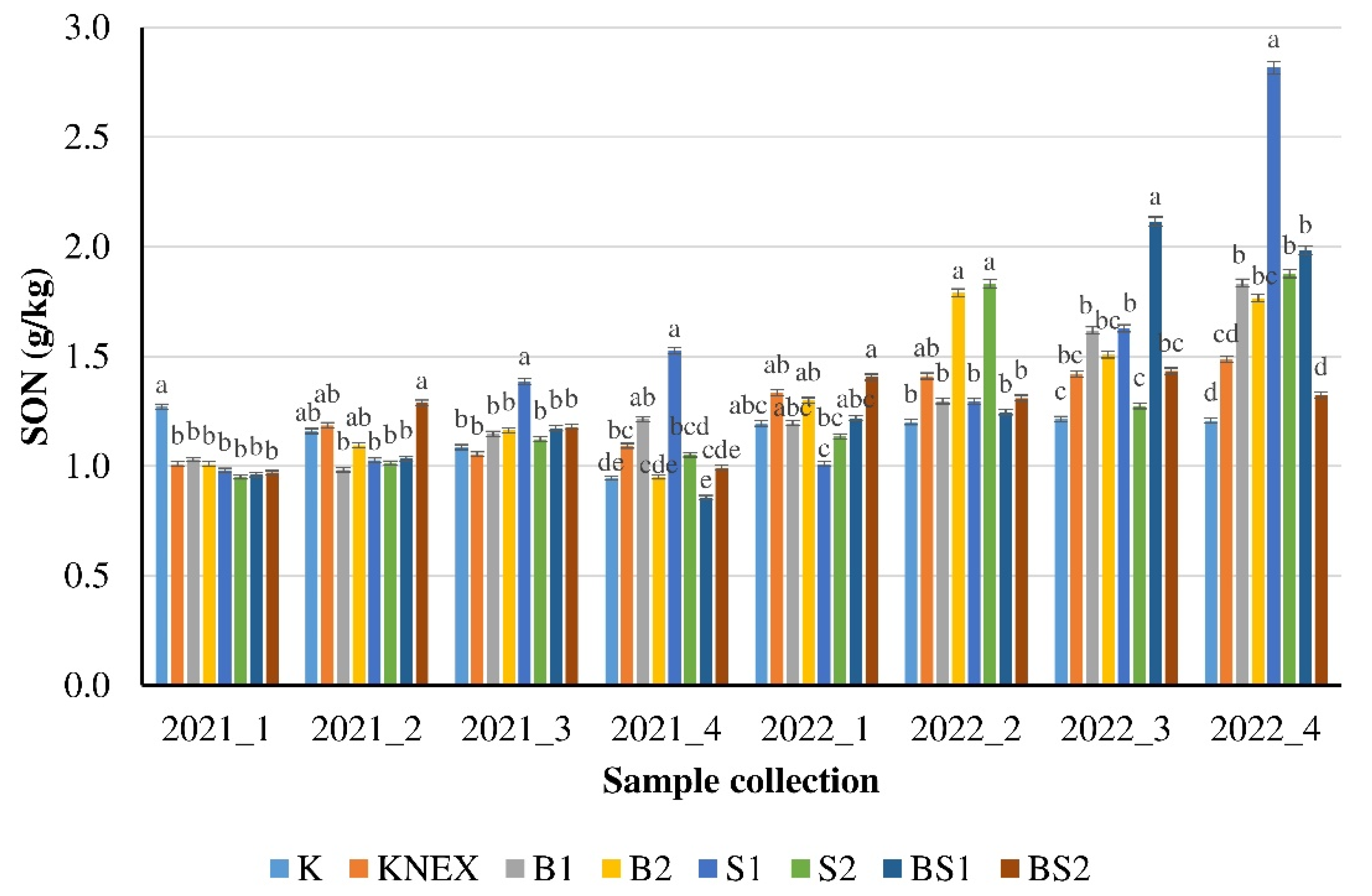
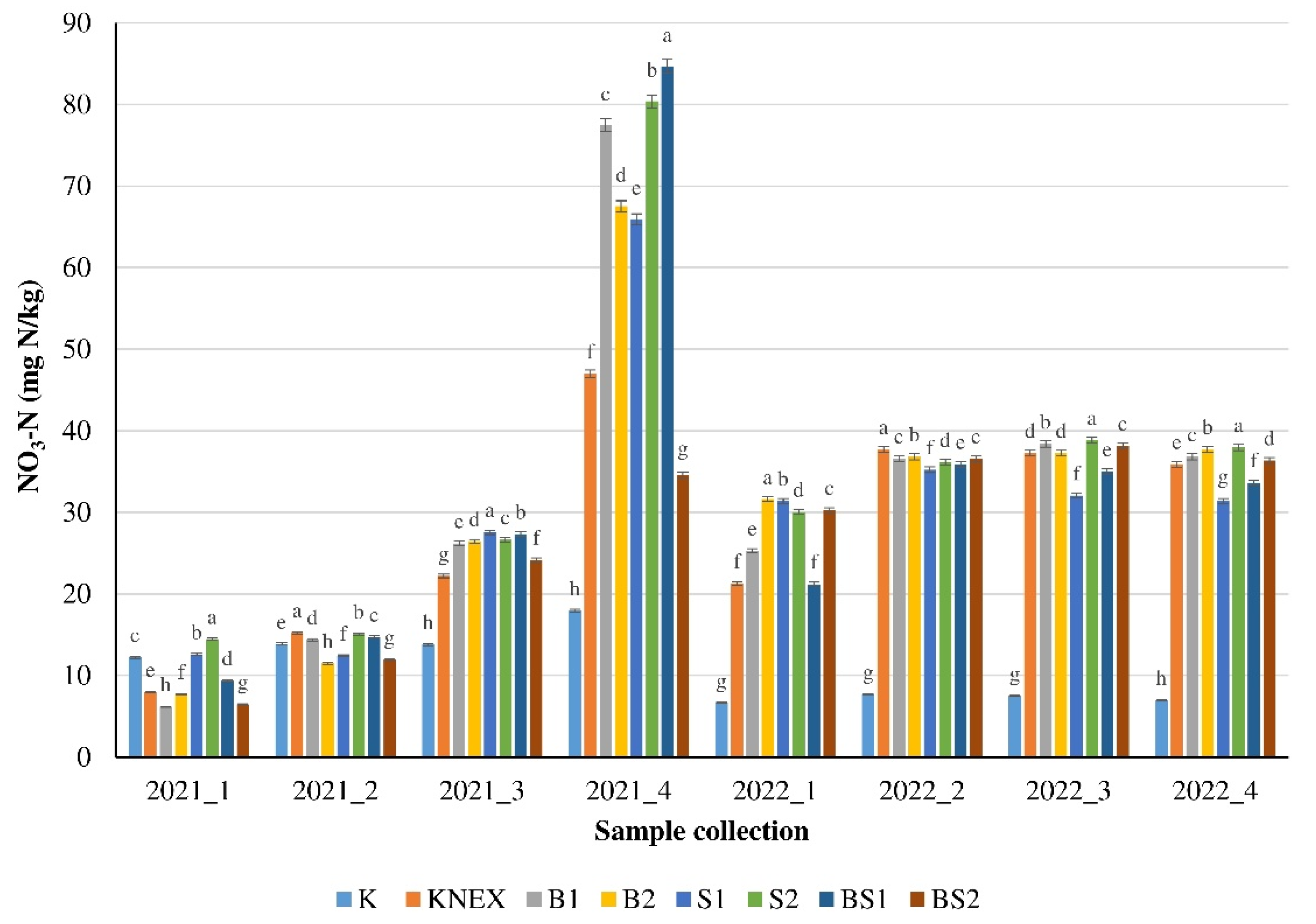
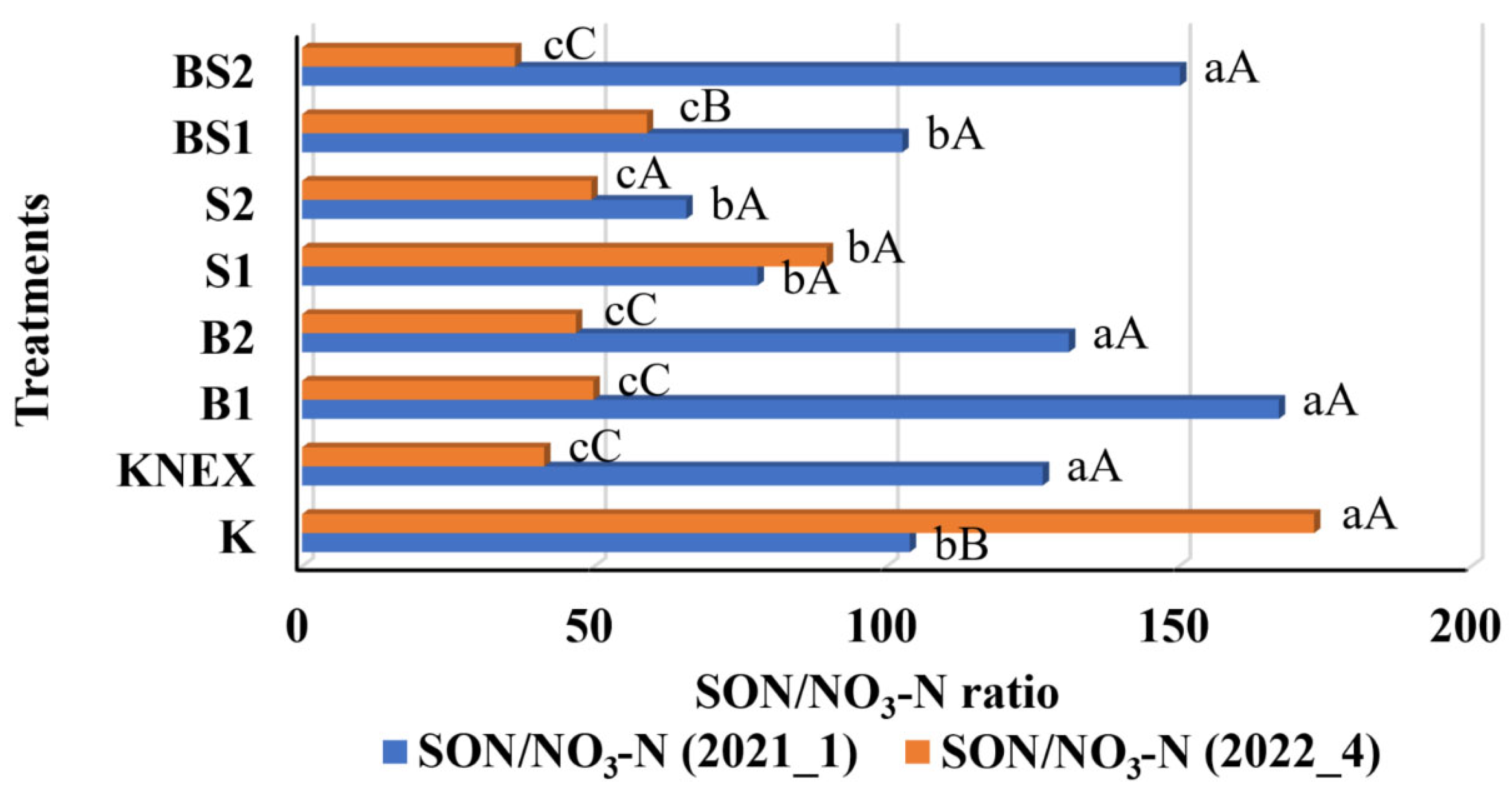
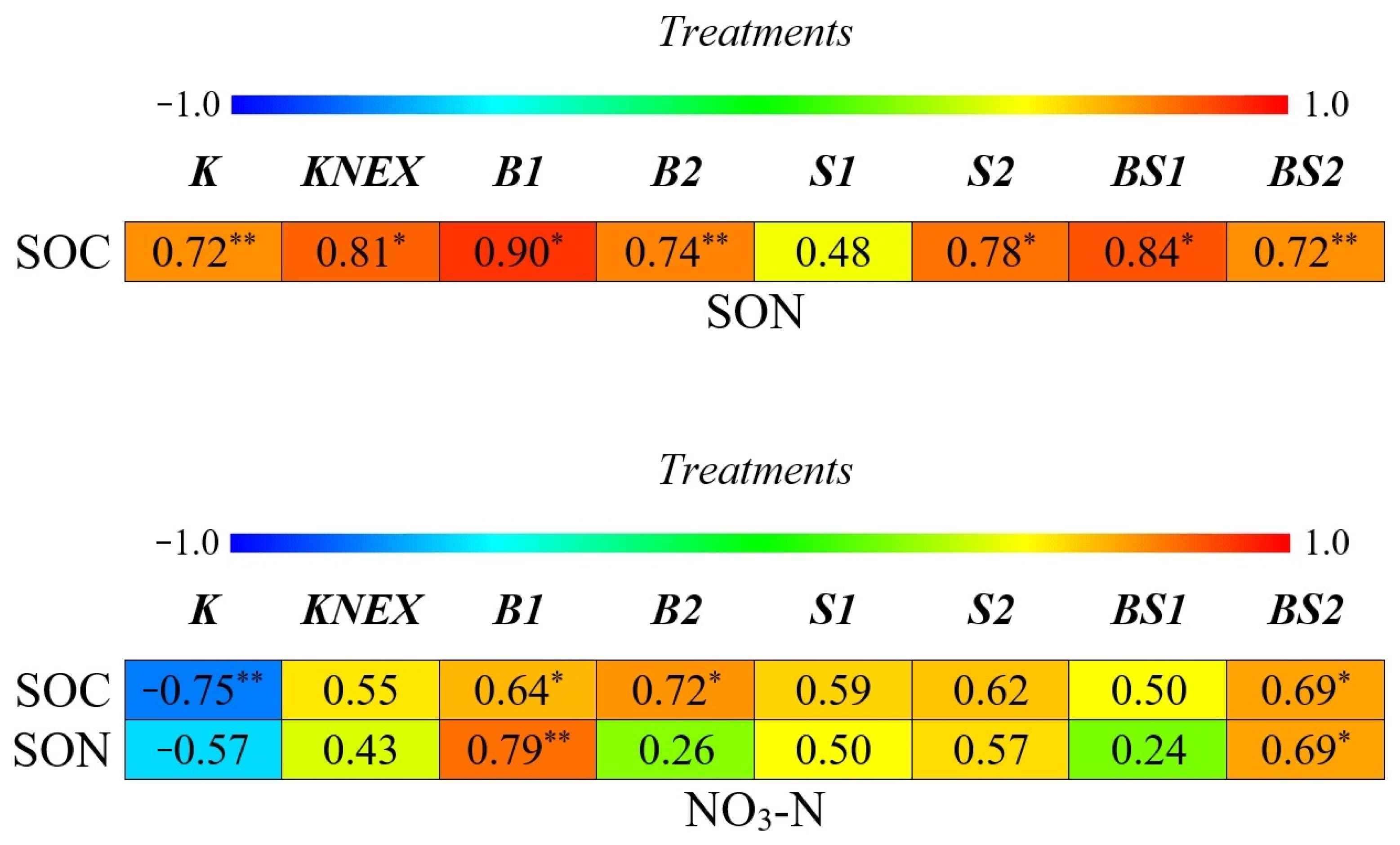



| Component | Value | Component | Value |
|---|---|---|---|
| Nitrogen (w/w%) | 5.50 | Fe (mg/kg) | 545.00 |
| Phosphorus (P2O5) (w/w%) | 3.00 | Mn (mg/kg) | 374.00 |
| Potassium (K2O) (w/w%) | 2.50 | Mo (mg/kg) | 3.66 |
| Ca (w/w%) | 6.00 | Zn (mg/kg) | 367.00 |
| Mg (w/w%) | 0.50 | Cu (mg/kg) | 53.30 |
| S (w/w%) | 1.00 | Moisture content (w/w%) | 12.00 |
| B (mg/kg) | 31.40 | pH | 7.20 |
| Treatments | Groups | Doses (kg/Tree) | ||
|---|---|---|---|---|
| NEX | Bentonite | SAP | ||
| K | Control | - | - | - |
| KNEX | NEX | 2 | - | - |
| B1 | B | 2 | 0.5 | - |
| B2 | 2 | 1.0 | - | |
| S1 | S | 2 | - | 0.1 |
| S2 | 2 | - | 0.2 | |
| BS1 | BS | 2 | 0.5 | 0.1 |
| BS2 | 2 | 1.0 | 0.2 | |
| Soil Parameters | Value |
|---|---|
| pH KCl | 6.14 ± 0.1 |
| Carbonate (wt.%) | <0.10 ± 0.02 |
| SOC (g/kg) | 11.50 ± 0.2 |
| P2O5-P(mg/kg) (AL) | 108.30 ± 18.3 |
| K2O-K(mg/kg) (AL) | 263.90 ± 48.2 |
| NO3-N KCl (mgN/kg) | 10.04 ± 0.1 |
| Mg (mg/kg) (KCl) | 180.00 ± 2.5 |
| SON (g/kg) | 0.96 ± 0.01 |
| Soil texture | |
| sand (m/m%) | 52.54 ± 0.2 |
| silt (m/m%) | 46.64 ± 0.2 |
| clay (m/m%) | 0.82 ± 0.2 |
| Treatment | N (wt.%) | P (wt.%) | K (wt.%) | Ca (wt.%) | Mg (wt.%) | |||||
|---|---|---|---|---|---|---|---|---|---|---|
| 2021 | 2022 | 2021 | 2022 | 2021 | 2022 | 2021 | 2022 | 2021 | 2022 | |
| K | 2.49 b | 2.49 c | 0.25 a | 0.21 a | 1.60 a | 1.37 c | 2.27 a | 2.54 a | 0.52 a | 0.47 ab |
| KNEX | 2.51 b | 2.47 d | 0.25 a | 0.21 a | 1.26 b | 1.74 a | 2.18 ab | 2.64 a | 0.48 b | 0.5 a |
| B1 | 2.60 a | 2.37 e | 0.25 a | 0.21 a | 1.09 c | 1.30 c | 2.13 b | 2.22 c | 0.54 a | 0.53 a |
| B2 | 2.48 b | 2.44 d | 0.26 a | 0.21 a | 1.33 b | 1.30 c | 2.03 c | 1.99 e | 0.52 a | 0.52 a |
| S1 | 2.58 a | 2.72 a | 0.24 a | 0.21 a | 1.12 c | 1.45 b | 1.96 d | 2.13 d | 0.48 b | 0.45 b |
| S2 | 2.49 b | 2.57 b | 0.23 a | 0.20 a | 1.03 c | 1.28 c | 2.08 c | 2.11 d | 0.50 ab | 0.48 a |
| BS1 | 2.47 b | 2.50 c | 0.27 a | 0.20 a | 1.15 c | 1.65 a | 2.26 a | 2.26 c | 0.58 a | 0.42 b |
| BS2 | 2.37 d | 2.66 a | 0.26 a | 0.21 a | 1.59 a | 1.51 b | 2.07 c | 2.17 d | 0.53 a | 0.50 a |
| Treatments | Yield (kg/Tree) | ||
|---|---|---|---|
| 2021 | 2022 | Average (2021–2022) | |
| K | 17.80 c | 28.70 c | 23.25 d |
| KNEX | 30.90 ab | 33.10 b | 32.00 b |
| B1 | 21.20 bc | 20.70 d | 20.95 d |
| B2 | 26.60 b | 26.80 c | 26.70 c |
| S1 | 32.10 a | 25.30 c | 28.70 b |
| S2 | 33.30 a | 26.40 c | 29.85 b |
| BS1 | 21.70 bc | 31.40 b | 26.55 c |
| BS2 | 34.30 a | 41.50 a | 37.90 a |
Disclaimer/Publisher’s Note: The statements, opinions and data contained in all publications are solely those of the individual author(s) and contributor(s) and not of MDPI and/or the editor(s). MDPI and/or the editor(s) disclaim responsibility for any injury to people or property resulting from any ideas, methods, instructions or products referred to in the content. |
© 2024 by the authors. Licensee MDPI, Basel, Switzerland. This article is an open access article distributed under the terms and conditions of the Creative Commons Attribution (CC BY) license (https://creativecommons.org/licenses/by/4.0/).
Share and Cite
Tóth, F.A.; Magyar, T.; Tamás, J.; Nagy, P.T. Improving the Nutrient Management of an Apple Orchard by Using Organic-Based Composites Derived from Agricultural Waste. Horticulturae 2024, 10, 172. https://doi.org/10.3390/horticulturae10020172
Tóth FA, Magyar T, Tamás J, Nagy PT. Improving the Nutrient Management of an Apple Orchard by Using Organic-Based Composites Derived from Agricultural Waste. Horticulturae. 2024; 10(2):172. https://doi.org/10.3390/horticulturae10020172
Chicago/Turabian StyleTóth, Florence Alexandra, Tamás Magyar, János Tamás, and Péter Tamás Nagy. 2024. "Improving the Nutrient Management of an Apple Orchard by Using Organic-Based Composites Derived from Agricultural Waste" Horticulturae 10, no. 2: 172. https://doi.org/10.3390/horticulturae10020172
APA StyleTóth, F. A., Magyar, T., Tamás, J., & Nagy, P. T. (2024). Improving the Nutrient Management of an Apple Orchard by Using Organic-Based Composites Derived from Agricultural Waste. Horticulturae, 10(2), 172. https://doi.org/10.3390/horticulturae10020172






